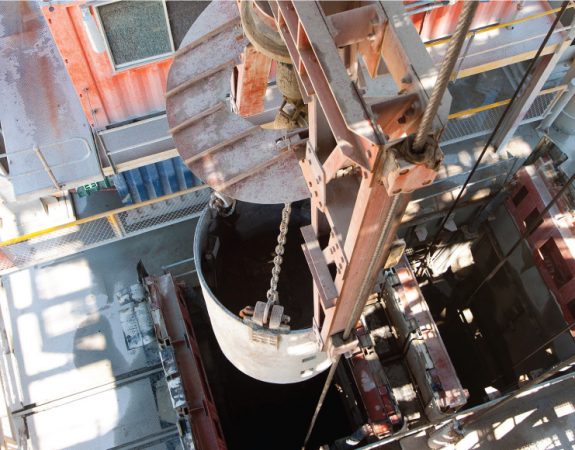Throughout its 60-year legacy, UMS has helped clients to extract value from the world’s most challenging orebodies. Over the last six decades, the organisation’s shaft sinking division it says “has gained invaluable experience and expertise from sinking more than 170 000 metres of vertical shafts across the globe. As a specialist in underground projects, UMS is continuously seeking ways to optimise safety and production during the shaft sinking process. UMS CEO Digby Glover talks about the innovations in shaft sinking that the company is applying across its international projects.”
“Shaft sinking has been evolving for years as hazards are identified and addressed through design and elimination. UMS is always striving to make the sinking process as safe as possible, and zero harm is the absolute objective for all of our projects,” says Glover. “Shaft sinking has become more mechanised and removing people completely from the shaft bottom is the driving factor for almost all innovations. That objective has been met for almost all parts of the sinking cycle.”
He adds: “For example, the cactus grab used for lashing or mucking of blasted material has been widely utilised in the sinking process across the world since its introduction in South Africa in the 1950s. It has a high loading rate, but is associated with safety hazards as there are various heavy operations that occur simultaneously with workers nearby. To eliminate the risks to workers, we are now using vertical shaft muckers and shaft drilling jumbos instead of cactus grabs for many projects. This allows us to do inline work as opposed to concurrent work with people working at the bottom. UMS has not thrown the baby out with the bath water in terms of cactus grabs. Where they are used, however, no persons are allowed on shaft bottom during the mucking cycle. This ensures the safety of our workers at all times and eliminates the possibility of an accident during this hazardous phase of the sinking cycle.”
He explains how using vertical shaft muckers will significantly improve operational safety at UMS’s flagship project in Botswana, as a single operator control allows for a pared-down team at the shaft bottom during mucking. UMS has also introduced remote-control equipment for the project to further increase the safety of workers and make conditions more ergonomic and comfortable for operators.
UMS’s scope for the diamond mine in Botswana is a twin shaft system to a depth of just over 750 m, including the initial studies, design, procurement and construction. The pre-sink has been completed and UMS is currently conducting changeover for the main sink. The project was initiated to extend the life of mine after the closure of the open pit.
In New Mexico, USA, UMS is undertaking another shaft sinking project, and has started to ramp up to full sink in May this year. “The headgear is erected, and the winders are currently being commissioned,” says Glover. “This will be a single ventilation shaft reaching a depth of almost 700 m that will be partially concrete lined, partially thin skin lined, and partially unlined.”
He says that safety is a massive focus for this project. “This shaft will be sunk using muckers, so the number of people in the shaft is dramatically reduced compared to conventional sinking, and there will be no concurrent activity with people working above each other. Blow over will be done by mechanised means, and there will be limited hand-held drilling. The workforce for this project is highly skilled and multi-tasked,” comments Glover.
He adds that UMS will be using a twin-boomed electrohydraulic shaft drilling jumbo that has been designed to be fully remote controlled. The drill is electrohydraulic to reduce noise to be less harmful and to increase drilling rates. The drills can rotate 90 degrees to drill sidewall support, removing hand-held jackhammer drills and reducing the risk to injuries. Mucking will be done by means of two sidewall-mounted clamshell loaders and the kibbles (buckets) will be loaded without disconnecting them from the ropes, so no manpower is required at the shaft bottom during the most hazardous part of the operation. The stage will be suspended off four ropes and an emergency escape hoist will be installed.
UMS will also be making use of remote-controlled equipment for an underground deepening project in Brazil. UMS’s scope has been the trade off and feasibility study and the company is now conducting detailed design, project planning as well as early procurement of long lead items. UMS expects to begin pre-sinking the 1,500 m-deep shaft later this year, as the copper mine extends its longevity by moving from open cast to underground.
“Today it is possible to sink a shaft without a single accident with the equipment and methodology described above,” says Glover. “Another innovation is the replacement of compressed air with hydraulics to reduce the potential for hearing loss and fatigue. Soon it will be eliminated completely. Now the focus is on productivity improvements to make shaft sinking more cost effective and improve the rate of return to improve the business case. We will continue to engage with our clients at concept or feasibility phase and assist in developing underground mining projects through to the construction phase in the safest and most productive way. We are in a unique position of being able to offer upfront engineering through to construction alongside our shaft sinking contracting skills. This combination offers significant value to our clients.”











